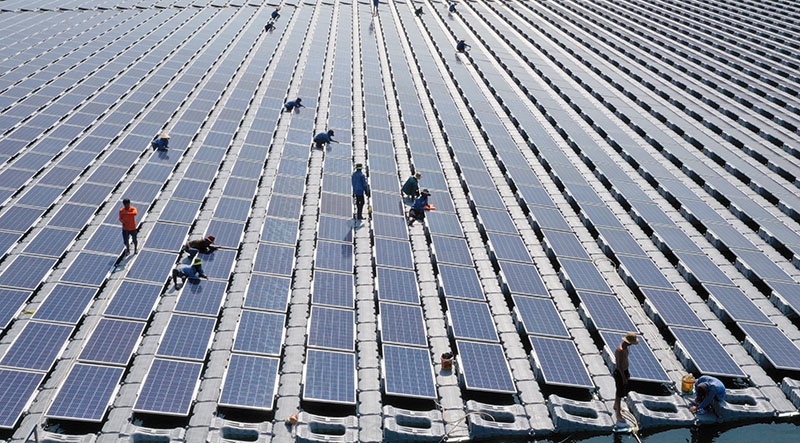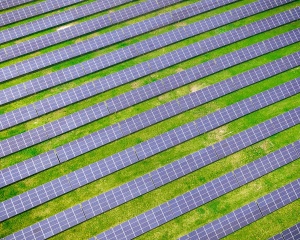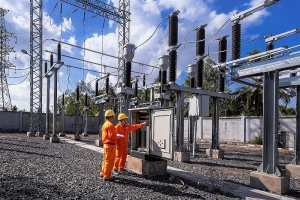Adjusting electricity tariff vital to the energy sector
 |
The increase in electricity prices remains a hot topic as it has a major impact on households and businesses alike. Vietnam Electricity (EVN) has proposed another increase in retail electricity prices to compensate for its losses.
Speaking at the state capital management in enterprises seminar last week, Nguyen Xuan Nam, vice president of EVN, said, "EVN accepts selling electricity at much lower prices than feed-in-tariffs (FiT). Although electricity prices have climbed three per cent in 2023, it only minimizes some parts of lingering difficulties since 2022. This year, retail electricity prices were not adjusted in a timely manner. As a result, EVN has incurred a loss of $1.48 billion."
He added, "EVN's main task is to ensure a sufficient supply of electricity to the economy. However, the company encounters many challenges in mobilising and balancing its capital to fund its initiatives and ensuring safe operation and sufficient electricity supply in the following years. In 2023, EVN plans to allocate $3.88 billion for its investment activities. This plan is affected due to the losses."
To ensure the supply and demand balance in 2024, EVN calculates that electricity demand will increase by 8.96 per cent compared with 2023.
In the last four months of this year, the total output of electricity generation and imports is estimated to reach 95.6 - 97.2 billion kWh for the entire system, up 10-12 per cent on-year.
In addition, the government is promoting the green economy, but the current FiT mechanism is not attractive enough to lure renewable energy developers. The top priority for businesses is making returns on investment. At this time, many businesses do not dare invest in renewable energy projects.
Many renewable energy projects are facing legal bottlenecks. This can be changed if policymakers issue mechanisms for research and development activities and invite international investors to co-develop sustainable energy in Vietnam. Prior to October 30, many businesses made heavy investments in renewable energy thanks to good policy and FiT.
At present, Vietnamese authorities have yet to unveil the FiT regime for renewable energy.
Nguyen Xuan Thanh, a lecturer at the Fulbright School of Public Policy and Management in Vietnam said, "The increase in electricity prices will spark the public's concerns without promoting the green transition. This is particularly true if renewable energy is not developed due to a lack of an attractive roadmap for the FiT increase."
According to Thanh, electricity prices should be updated with a comprehensive calculation of new and arising production costs. There has been a proliferation of new energy sources, many of which are more expensive than the present average price of power.
As a rough estimate, if the cost of renewable energy stands between 5-7 US cents per kWh, with the addition of transmission costs, the retail price should rise to 10-12 US cents per kWh. However, the average retail price hovers around 8 US cents per kWh.
Thanh further noted that it was vital to accelerate electricity price bidding for renewable energy plants. This helps take advantage of wind and solar energy projects with low operation costs. The renewable energy sources will also balance the shortage of electricity.
"Renewable energy producers prefer guaranteed contracts. However, they would be equally happy with a transparent bidding process that was supervised by a separate regulatory authority," he added.
In September, the Ministry of Industry and Trade issued Report No.158/BC-BCT to the prime minister on researching and building a direct power purchase agreement between renewable energy generators and big customers.
"While the auction process is still being developed, an alternative solution is long-term fixed contracts at set rates, which is similar to fossil fuel energy projects. Such contracts might make it easier to obtain bank loans and longer-term, less expensive international borrowings,”Thanh said.
However, he warned, since the risk of energy dispatching is transferred from wind and solar plants to electricity buyers, these contracts may impose additional costs on the state.
"People and businesses are willing to pay for clean electricity. Businesses are paying attention to electricity prices for transitional renewable energy projects," said Hoang Xuan Co, general secretary of the Vietnam Association of Environmental Economics.
"However, renewable energy developers are facing challenges due to a lack of basic research and technology, as well as conversion and grid connection equipment, leading to higher expenses for electricity generation. There is a shortage of scientific ground to figure out the feed-in tariffs for wind and solar energy. With comprehensive research, it is possible to figure out the expenses for developing wind and solar energy projects in specific areas. This will facilitate the shift to green energy."
| - According to National Power Development Plan VIII, by 2030, the total capacity of power plants serving domestic demand will be almost 150,500MW, excluding exports, existing rooftop solar power, and renewable energy to produce new energy. Among them, onshore wind power is 21,880MW (14.5 per cent of the total capacity of power plants); offshore wind power is 6,000MW (4 per cent); and solar power is around 12,840MW (8.5 per cent). - Before the end of September, the Ministry of Industry and Trade will report to the government on the retail electricity tariff structure. The ministry submitted the supplementary report for the decision on the mechanism to adjust retail power tariffs in August. |
 | Electricity prices must reflect production costs for green transition Nguyen Xuan Thanh, a lecturer at the Fulbright School of Public Policy and Management in Vietnam, has suggested that for a successful green transition, Vietnam must accurately adjust electricity prices to mirror the costs of renewable energy production. |
 | Vietnam Electricity incurs further losses so far this year Vietnam Electricity (EVN) has recorded losses of $1.21 billion in the first eight months of this year, adding to last year's woes. |
 | EVN proposes accelerated electricity imports from Laos Amidst a looming power deficit, Vietnam Electricity (EVN) is fostering strategic partnerships with Laotian electricity suppliers to ensure the country's energy security. By leveraging competitive pricing structures, EVN proposes accelerating the imports from Laos. |
What the stars mean:
★ Poor ★ ★ Promising ★★★ Good ★★★★ Very good ★★★★★ Exceptional
 Tag:
Tag:
Related Contents
Latest News
More News
- SABECO to elevate Vietnam's beverage industry to global standards (November 21, 2024 | 17:36)
- ABeam Consulting Vietnam introduces BSQCD Purchasing Strategy Framework (November 21, 2024 | 16:40)
- Major railway requires debt considerations (November 21, 2024 | 12:07)
- Reviving a new life cycle for plastic waste (November 21, 2024 | 09:16)
- Key balances maintained for industrial production (November 21, 2024 | 08:00)
- Ecolean Vietnam honoured with prestigious sustainability award (November 19, 2024 | 10:01)
- HEINEKEN Vietnam’s clear path towards net-zero (November 18, 2024 | 15:13)
- VLCA 2024 honours corporate governance excellence as listed companies raise the bar (November 18, 2024 | 09:00)
- High-tech personnel to drive competition (November 17, 2024 | 09:21)
- Rising use of Generative AI Apps boosts consumer interest in differentiated connectivity (November 16, 2024 | 09:41)






















 Mobile Version
Mobile Version